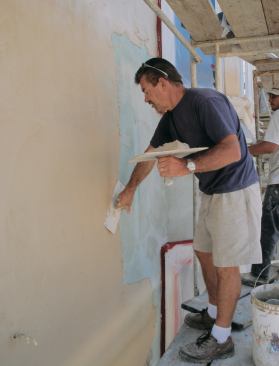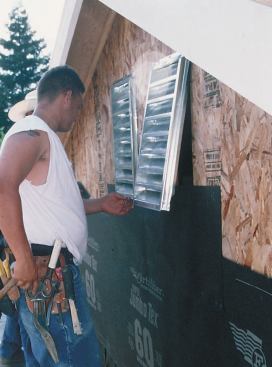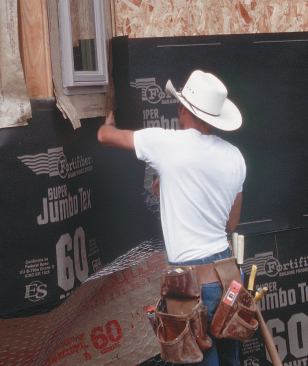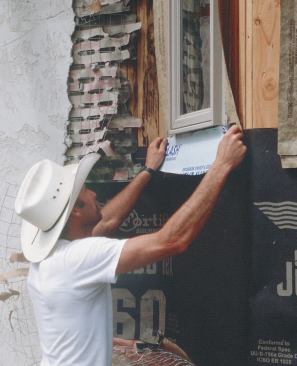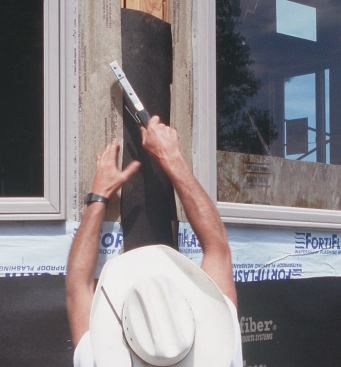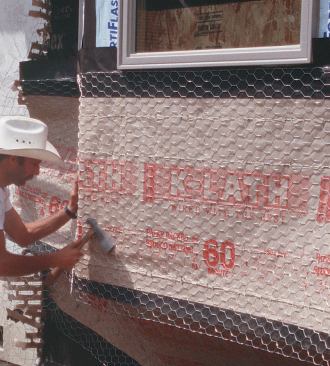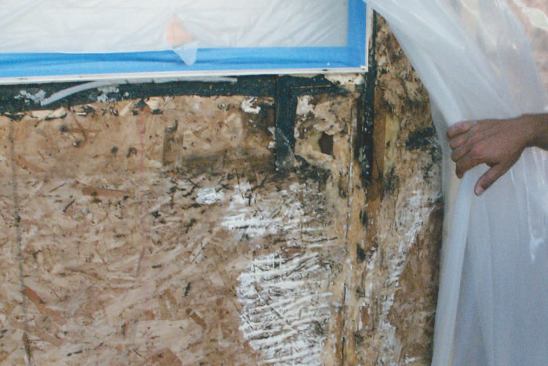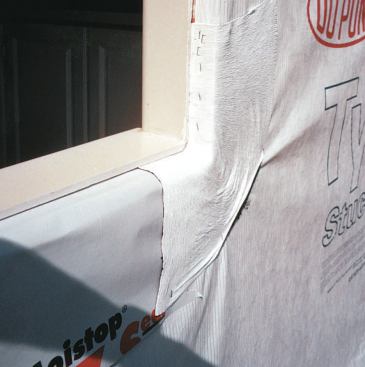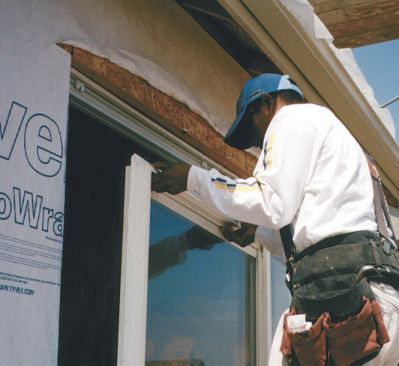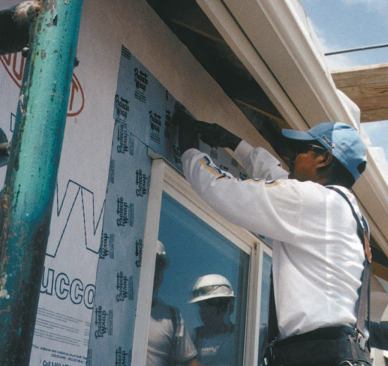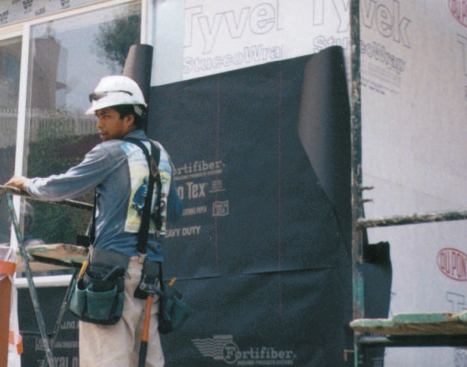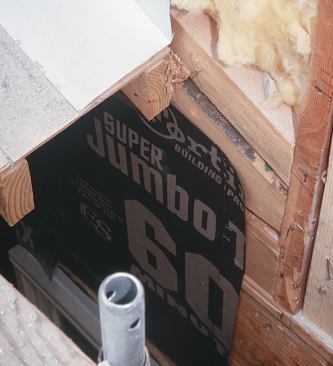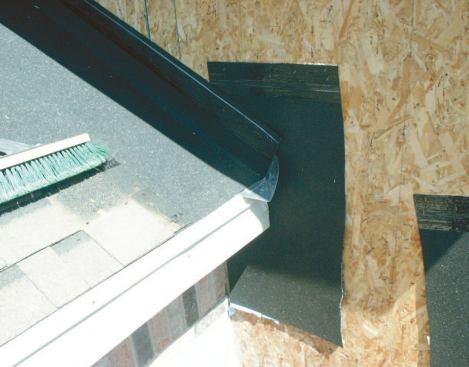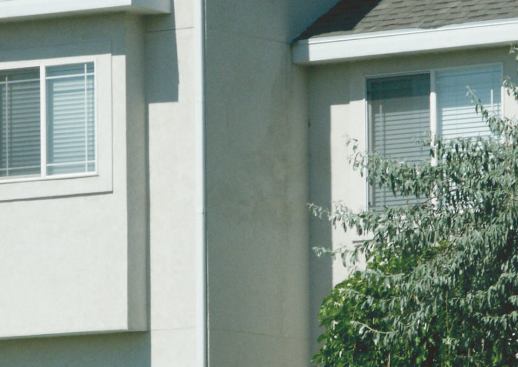One-Coat Stucco
Since the mid-1980s, a handful of manufacturers have introduced thin-coat stucco products that collectively are called “one-coat” (or sometimes “two-coat”) stucco. One-coat is nearly identical to conventional stucco in concept and design, except that the base coat is applied in one layer instead of the original two-step scratch- and brown-coat process. The base coat is mostly sand and Portland cement, as in conventional stucco, but it also includes synthetic polymers and fiberglass reinforcing strands that increase both the tensile and the compressive strength. The required total thickness is just 3/8 inch, instead of the standard 3/4-inch total for the three-coat base.
The idea behind one-coat systems was to save labor and time in the schedule. With the added components, base coat could be put on in just one layer, with no second plastering and no wait in between.
In practice, I’m not sure one-coat is all that economical. The proprietary mix ingredients add cost, and finding and following the special instructions for the proprietary systems add complexity. One experienced stucco contractor, a friend whose work I respect, told me that he gave up working with one-coat because it was too complicated. His crews rebelled against the required special detailing, and he also found that with only 3/8 inch of thickness, it was harder to achieve a nice, uniform finish over the usual irregularities in a house frame. (A common defect I see in one-coat installations is a base coat much thinner than the required 3/8 inch, at least in spots.)
The other big selling point for thin-coat systems is that the fiberglass and polymer additives help the stucco withstand the winter freeze-thaw cycle.
The thinner base coat is still applied over wire lath or expanded metal, and over a system of papers and flashing the same as we need for conventional stucco. The same screeds and expansion joints are also part of this system, although at different thicknesses. But unlike three-coat stucco, one-coat systems require a 48-hour moist cure. The applicator is responsible for keeping the base coat moist for the first 48 hours after application. The color finish is also required to go on within 72 hours of the base coat application. Proper curing is more critical with one-coat than with traditional stucco, because the acrylics tend to isolate cement particles from water in the mix. If the coat isn’t kept moist, it may dry out before the cement has a chance to react with water (hydrate), which it must do to form the strong cement compounds that give the cladding its strength. Without the correct moist cure, the base coat is likely to be weak and crumbly.
One-coat stucco usually receives one of the new acrylic color finishes, instead of traditional stucco’s purely cementitious, textured color coat. It has a smoother and less porous look, because acrylics instead of cement bind the aggregates together — it’s like sand mixed with latex paint. Many people perceive this acrylic top coat as the defining characteristic of one-coat stucco, but synthetic finishes are not really an essential component of a one-coat system — they just happened to be developed about the same time that one-coat was widely marketed. One-coat base-coat systems got code approval in ER reports without mention of any particular color finish. As long as the base coat is applied at least 3/8 inch thick, you can paint it or apply either a conventional cement color finish or a synthetic acrylic color finish over it.
An acrylic coating’s higher plasticity gives more resistance to cracking and creates a more closed, water- and stain-resistant surface. But one-coat stucco finishes are still porous enough to let rain enter the system — the perception that one-coat systems reliably repel water at the surface is incorrect. And even if the coatings were waterproof, one-coat systems do crack, and they can leak at all the joints and penetrations, so water is sure to get behind them. At the same time, they are less breathable and slower to dry out than conventional stucco. So they are less forgiving of any defect in the proper placement of building papers, flashing, and lathing staples — if water reaches the wood structure of the house, it is less able to escape by evaporation.
I’ve seen many failed stucco systems that someone has tried to repair by applying a thick polymer coat over the existing stucco, and by surface- caulking window and other joints. This is worse than useless — it actually accelerates the damage. Water will still enter the system somewhere, and then it’s trapped next to the house. My company’s educational video, available from our website at www.ram builders.com, shows an example of a home just four years old, whose framing and sheathing is completely gone because of that kind of attempted “repair.” Damage that might have taken 10 or 20 years to develop under normal, breathable stucco happened in 1 or 2 years after the sealer was applied.
EIFS
Exterior insulation and finish systems use just a thin (1/8-inch to 3/16-inch) synthetic top coat over a substrate of expanded polystyrene foam. Originally designed as a barrier system with no water management behind the foam, EIFS in the residential market now has to have reliable paper and flashing assemblies behind it to allow water to drain. However, EIFS still requires surface caulking and sealing at joints (caulking is not part of a hard-coat stucco system).
The details for EIF systems are all specified by manufacturers in their specs and ER reports. In practice, I’ve found that EIFS applicators still mix and match in the field, using whatever components are cheap or easy to find, and assembling the system however they feel like doing it. With constant pressure on budgets and schedules, it’s not surprising that we still find defective EIFS applications all over the market.
Even the new water-managed EIF systems use sealing top coats, so they lack the easy path for moisture escape that traditional stucco has. With EIFS, any water in the system has to make its way to weep exits — it can’t readily bleed or evaporate out the face of the wall.
